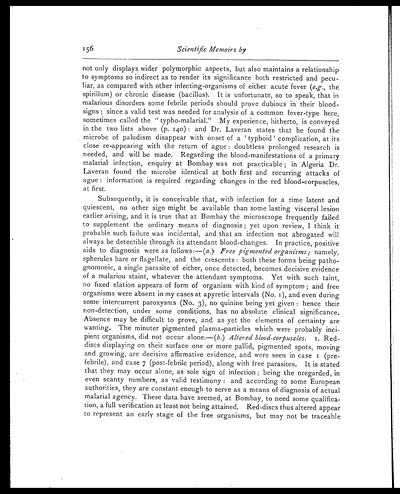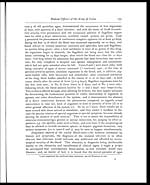Medicine - Institutions > Army health reports and medical documents > Scientific memoirs by medical officers of the Army of India > Part III, 1887 > 10 - Note on some aspects and relations of the blood-organisms in ague
(162) Page 156
Download files
Individual page:
Thumbnail gallery: Grid view | List view

156
Scientific Memoirs by
not only displays wider polymorphic aspects, but also maintains a relationship
to symptoms so indirect as to render its significance both restricted and pecu-
liar, as compared with other infecting-organisms of either acute fever (e.g., the
spirillum) or chronic disease (bacillus). It is unfortunate, so to speak, that in
malarious disorders some febrile periods should prove dubious in their blood-
signs; since a valid test was needed for analysis of a common fever-type here,
sometimes called the "typho-malarial." My experience, hitherto, is conveyed
in the two lists above (p. 140): and Dr. Laveran states that he found the
microbe of paludism disappear with onset of a ‘typhoid’ complication, at its
close re-appearing with the return of ague: doubtless prolonged research is
needed, and will be made. Regarding the blood-manifestations of a primary
malarial infection, enquiry at Bombay was not practicable; in Algeria Dr.
Laveran found the microbe identical at both first and recurring attacks of
ague: information is required regarding changes in the red blood-corpuscles,
at first.
Subsequently, it is conceivable that, with infection for a time latent and
quiescent, no other sign might be available than some lasting visceral lesion
earlier arising, and it is true that at Bombay the microscrope frequently failed
to supplement the ordinary means of diagnosis; yet upon review, I think it
probable such failure was incidental, and that an infection not abrogated will
always be detectible through its attendant blood-changes. In practice, positive
aids to diagnosis were as follows:—(a. ) Free pigmented organisms; namely,
spherules bare or flagellate, and the crescents: both these forms being patho-
gnomonic, a single parasite of either, once detected, becomes decisive evidence
of a malariou staint, whatever the attendant symptoms. Yet with such taint,
no fixed elation appears of form of organism with kind of symptom; and free
organisms were absent in my cases at apyretic intervals (No. 1), and even during
some intercurrent paroxysms (No. 3), no quinine being yet given: hence their
non-detection, under some conditions, has no absolute clinical significance.
Absence may be difficult to prove, and as yet the elements of certainty are
wanting. The minuter pigmented plasma-particles which were probably inci-
pient organisms, did not occur alone.—(b. ) Altered blood-corpuscles. I. Red-
discs displaying on their surface one or more pallid, pigmented spots, moving
and growing, are decisive affirmative evidence, and were seen in case 1 (pre-
febrile), and case 7 (post-febrile period), along with free parasites. It is stated
that they may occur alone, as sole sign of infection; being the nregarded, in
even scanty numbers, as valid testimony: and according to some European
authorities, they are constant enough to serve as a means of diagnosis of actual
malarial agency. These data have seemed, at Bombay, to need some qualifica-
tion, a full verification at least not being attained. Red-discs thus altered appear
to represent an early stage of the free organisms, but may not be traceable
Set display mode to: Large image | Zoom image | Transcription
Images and transcriptions on this page, including medium image downloads, may be used under the Creative Commons Attribution 4.0 International Licence unless otherwise stated. ![]()
| Permanent URL | https://digital.nls.uk/75004492 |
|---|
| Shelfmark | IP/QB.10 |
|---|---|
| Additional NLS resources: | |




